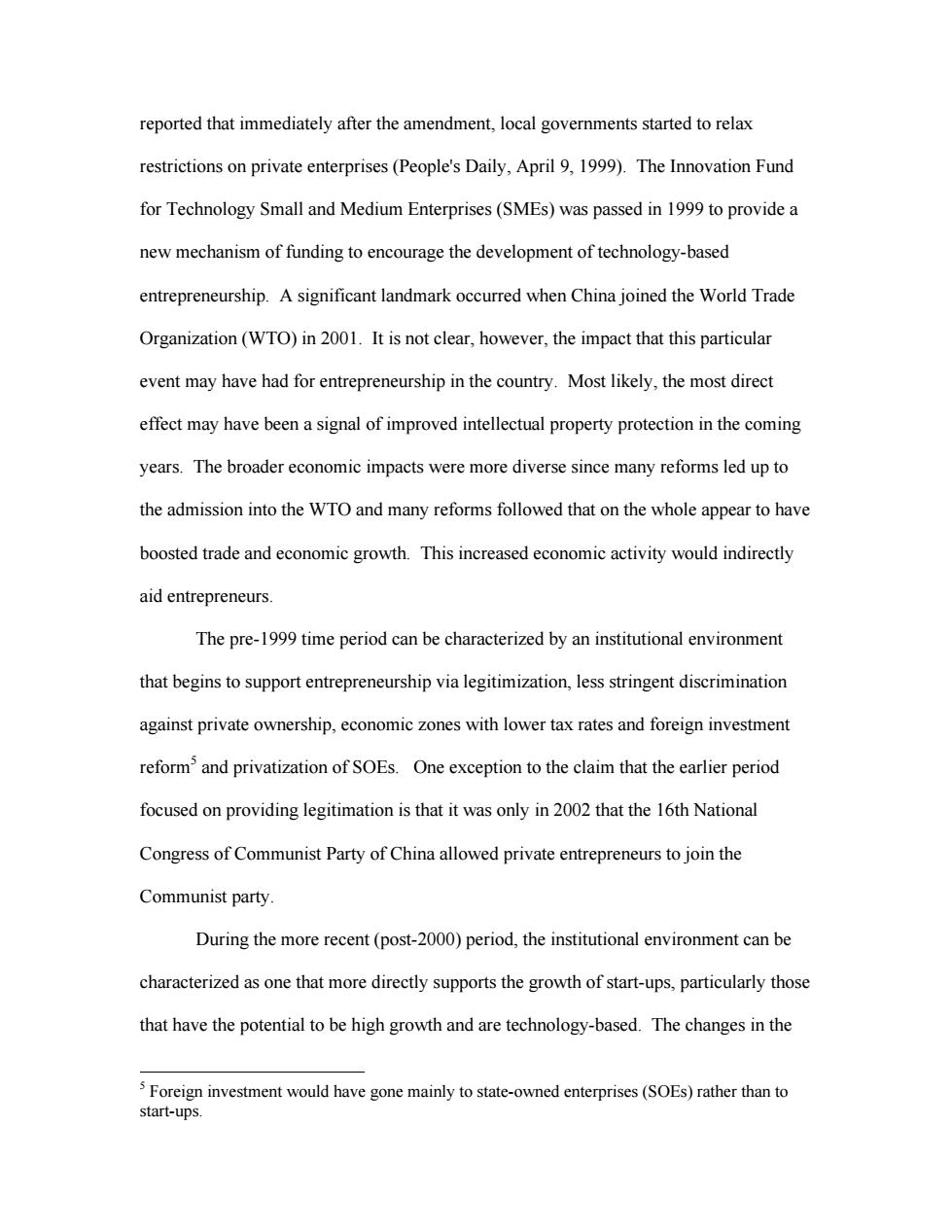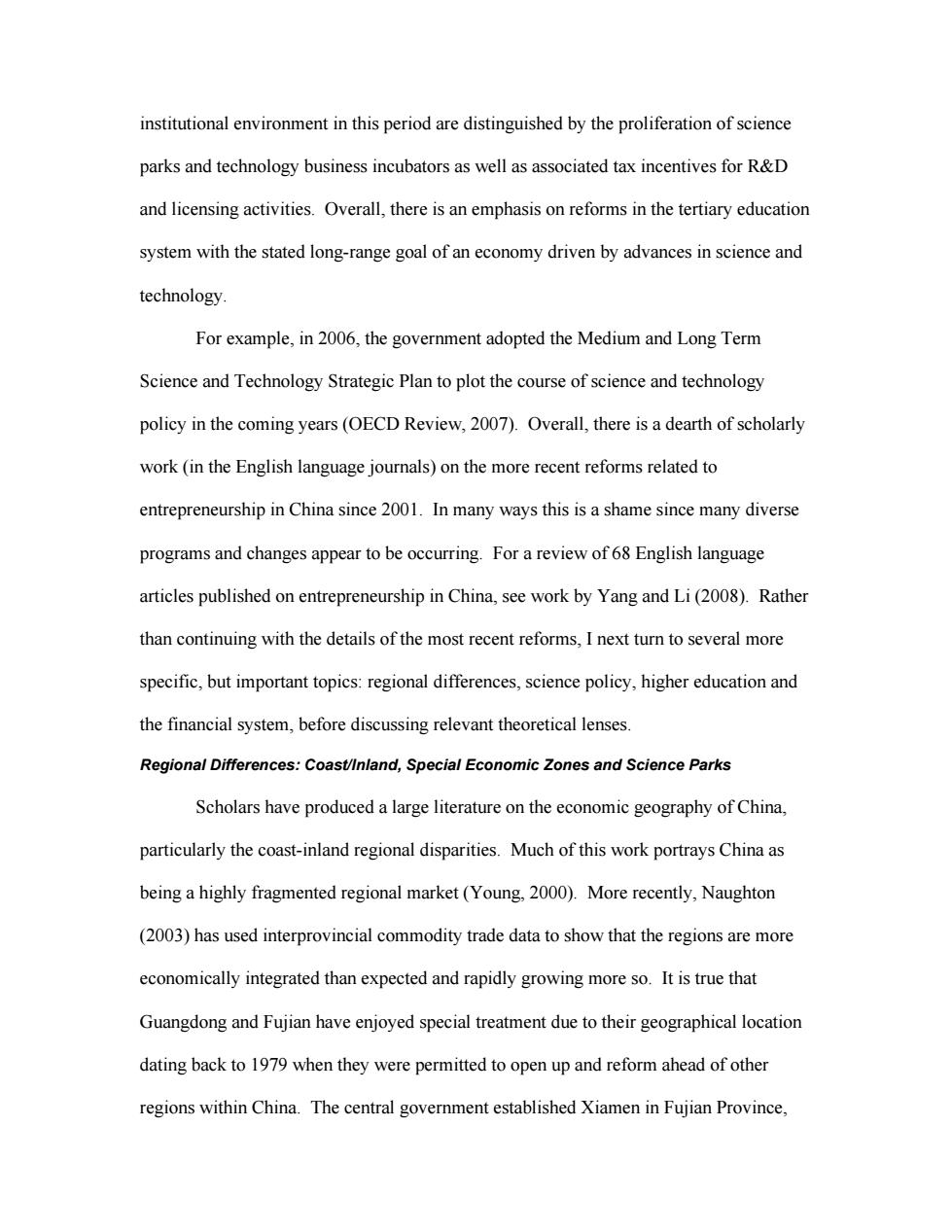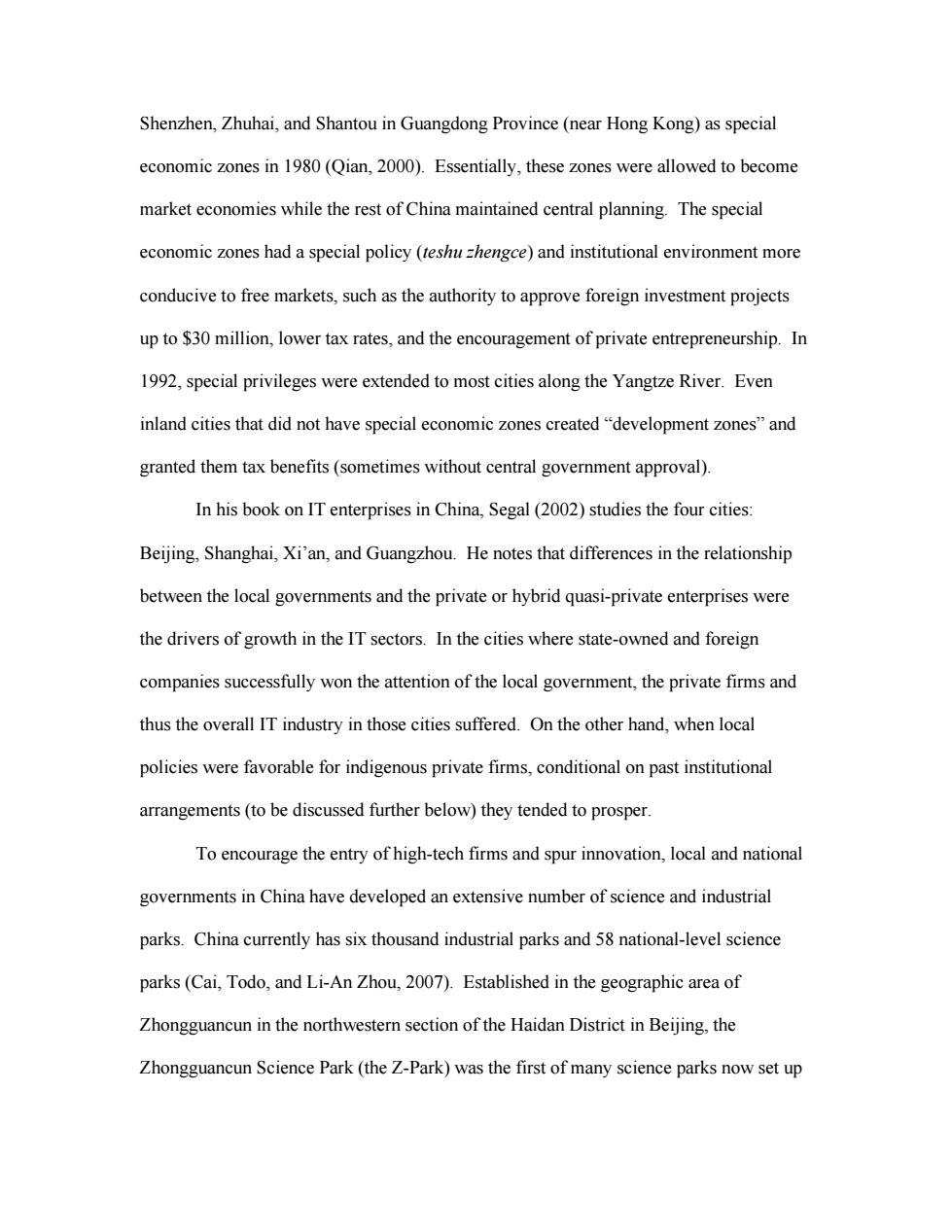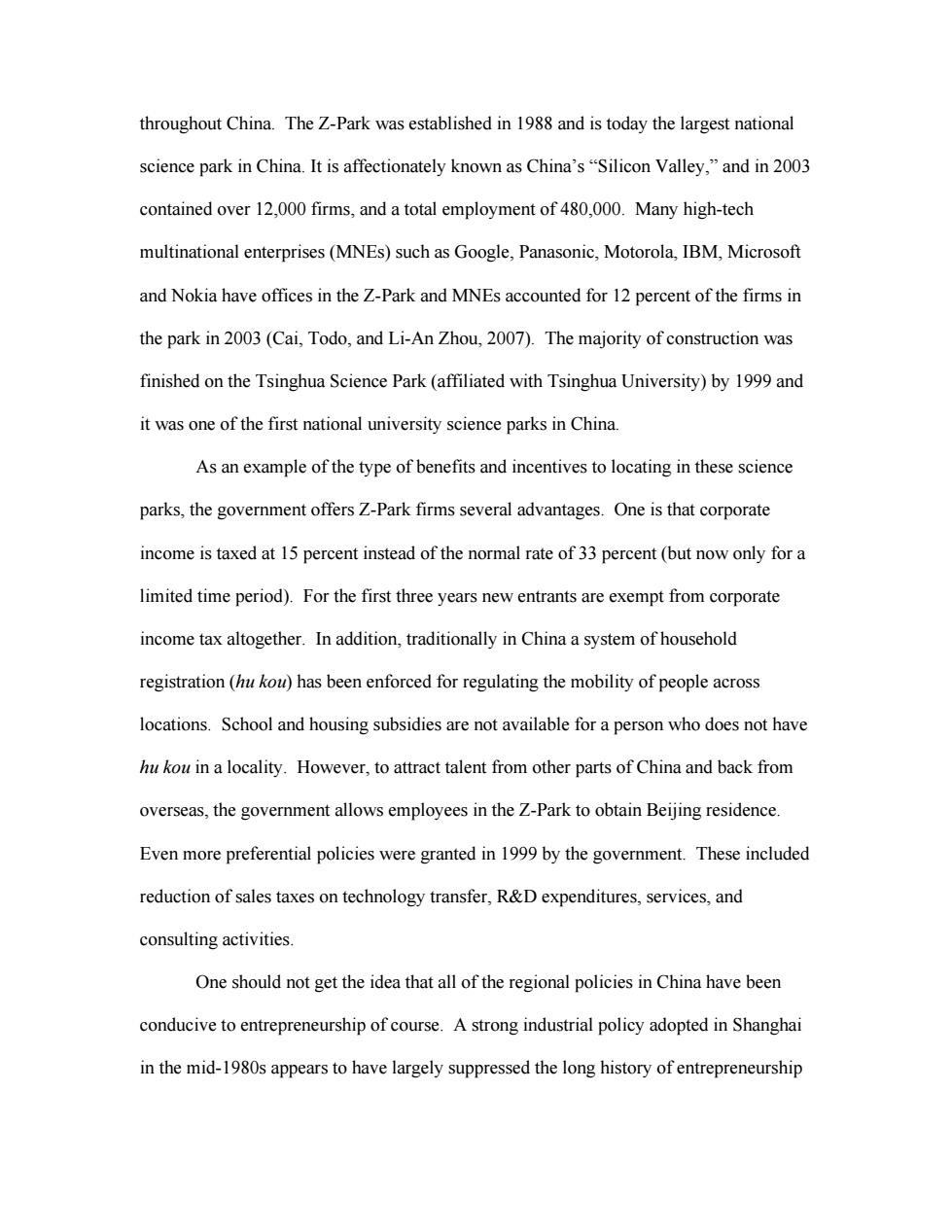
reported that immediately after the amendment,local governments started to relax restrictions on private enterprises(People's Daily,April 9,1999).The Innovation Fund for Technology Small and Medium Enterprises(SMEs)was passed in 1999 to provide a new mechanism of funding to encourage the development of technology-based entrepreneurship.A significant landmark occurred when China joined the World Trade Organization(WTO)in 2001.It is not clear,however,the impact that this particular event may have had for entrepreneurship in the country.Most likely,the most direct effect may have been a signal of improved intellectual property protection in the coming years.The broader economic impacts were more diverse since many reforms led up to the admission into the WTO and many reforms followed that on the whole appear to have boosted trade and economic growth.This increased economic activity would indirectly aid entrepreneurs. The pre-1999 time period can be characterized by an institutional environment that begins to support entrepreneurship via legitimization,less stringent discrimination against private ownership.economic zones with lower tax rates and foreign investment reformand privatization of SOEs.One exception to the claim that the earlier period focused on providing legitimation is that it was only in 2002 that the 16th National Congress of Communist Party of China allowed private entrepreneurs to join the Communist party. During the more recent(post-2000)period,the institutional environment can be characterized as one that more directly supports the growth of start-ups,particularly those that have the potential to be high growth and are technology-based.The changes in the Foreign investment would have gone mainly to state-owned enterprises(SOEs)rather than to start-ups
reported that immediately after the amendment, local governments started to relax restrictions on private enterprises (People's Daily, April 9, 1999). The Innovation Fund for Technology Small and Medium Enterprises (SMEs) was passed in 1999 to provide a new mechanism of funding to encourage the development of technology-based entrepreneurship. A significant landmark occurred when China joined the World Trade Organization (WTO) in 2001. It is not clear, however, the impact that this particular event may have had for entrepreneurship in the country. Most likely, the most direct effect may have been a signal of improved intellectual property protection in the coming years. The broader economic impacts were more diverse since many reforms led up to the admission into the WTO and many reforms followed that on the whole appear to have boosted trade and economic growth. This increased economic activity would indirectly aid entrepreneurs. The pre-1999 time period can be characterized by an institutional environment that begins to support entrepreneurship via legitimization, less stringent discrimination against private ownership, economic zones with lower tax rates and foreign investment reform5 and privatization of SOEs. One exception to the claim that the earlier period focused on providing legitimation is that it was only in 2002 that the 16th National Congress of Communist Party of China allowed private entrepreneurs to join the Communist party. During the more recent (post-2000) period, the institutional environment can be characterized as one that more directly supports the growth of start-ups, particularly those that have the potential to be high growth and are technology-based. The changes in the 5 Foreign investment would have gone mainly to state-owned enterprises (SOEs) rather than to start-ups

institutional environment in this period are distinguished by the proliferation of science parks and technology business incubators as well as associated tax incentives for R&D and licensing activities.Overall,there is an emphasis on reforms in the tertiary education system with the stated long-range goal of an economy driven by advances in science and technology For example,in 2006,the government adopted the Medium and Long Term Science and Technology Strategic Plan to plot the course of science and technology policy in the coming years(OECD Review,2007).Overall,there is a dearth of scholarly work(in the English language journals)on the more recent reforms related to entrepreneurship in China since 2001.In many ways this is a shame since many diverse programs and changes appear to be occurring.For a review of 68 English language articles published on entrepreneurship in China,see work by Yang and Li(2008).Rather than continuing with the details of the most recent reforms,I next turn to several more specific,but important topics:regional differences,science policy,higher education and the financial system,before discussing relevant theoretical lense Regional Differences:Coast/Inland,Special Economic Zones and Science Parks Scholars have produced a large literature on the economic geography of China particularly the coast-inland regional disparities.Much of this work portrays China as being a highly fragmented regional market(Young.2000).More recently,Naughton (2003)has used interprovincial commodity trade data to show that the regions are more economically integrated than expected and rapidly growing more so.It is true that Guangdong and Fujian have enjoyed special treatment due to their geographical location dating back to 1979 when they were permitted to open up and reform ahead of other regions within China.The central government established Xiamen in Fujian Province
institutional environment in this period are distinguished by the proliferation of science parks and technology business incubators as well as associated tax incentives for R&D and licensing activities. Overall, there is an emphasis on reforms in the tertiary education system with the stated long-range goal of an economy driven by advances in science and technology. For example, in 2006, the government adopted the Medium and Long Term Science and Technology Strategic Plan to plot the course of science and technology policy in the coming years (OECD Review, 2007). Overall, there is a dearth of scholarly work (in the English language journals) on the more recent reforms related to entrepreneurship in China since 2001. In many ways this is a shame since many diverse programs and changes appear to be occurring. For a review of 68 English language articles published on entrepreneurship in China, see work by Yang and Li (2008). Rather than continuing with the details of the most recent reforms, I next turn to several more specific, but important topics: regional differences, science policy, higher education and the financial system, before discussing relevant theoretical lenses. Regional Differences: Coast/Inland, Special Economic Zones and Science Parks Scholars have produced a large literature on the economic geography of China, particularly the coast-inland regional disparities. Much of this work portrays China as being a highly fragmented regional market (Young, 2000). More recently, Naughton (2003) has used interprovincial commodity trade data to show that the regions are more economically integrated than expected and rapidly growing more so. It is true that Guangdong and Fujian have enjoyed special treatment due to their geographical location dating back to 1979 when they were permitted to open up and reform ahead of other regions within China. The central government established Xiamen in Fujian Province

Shenzhen,Zhuhai,and Shantou in Guangdong Province(near Hong Kong)as special economic zones in 1980(Qian,2000).Essentially,these zones were allowed to become market economies while the rest of China maintained central planning.The special economic zones had a special policy (teshu zhengce)and institutional environment more conducive to free markets,such as the authority to approve foreign investment projects up to $30 million,lower tax rates,and the encouragement of private entrepreneurship.In 1992.special privileges were extended to most cities along the Yangtze River.Even inland cities that did not have special economic zones created"development zones"and granted them tax benefits(sometimes without central government approval) In his book on ITenterprises in China,Segal (2002)studies the four cities Beijing,Shanghai,Xi'an,and Guangzhou.He notes that differences in the relationship between the local governments and the private or hybrid quasi-private enterprises were the drivers of growth in the IT sectors.In the cities where state-owned and foreign companies successfully won the attention of the local government,the private firms and thus the overall IT industry in those cities suffered.On the other hand,when local policies were favorable for indigenous private firms,conditional on past institutional arrangements(to be discussed further below)they tended to prosper To encourage the entry of high-tech firms and spur innovation,local and nationa governments in China have developed an extensive number of science and industrial parks.China currently has six thousand industrial parks and 58 national-level science parks(Cai,Todo,and Li-An Zhou,2007).Established in the geographic area of Zhongguancun in the northwestern section of the Haidan District in Beijing.the Zhongguancun Science Park(the Z-Park)was the first of many science parks now set up
Shenzhen, Zhuhai, and Shantou in Guangdong Province (near Hong Kong) as special economic zones in 1980 (Qian, 2000). Essentially, these zones were allowed to become market economies while the rest of China maintained central planning. The special economic zones had a special policy (teshu zhengce) and institutional environment more conducive to free markets, such as the authority to approve foreign investment projects up to $30 million, lower tax rates, and the encouragement of private entrepreneurship. In 1992, special privileges were extended to most cities along the Yangtze River. Even inland cities that did not have special economic zones created “development zones” and granted them tax benefits (sometimes without central government approval). In his book on IT enterprises in China, Segal (2002) studies the four cities: Beijing, Shanghai, Xi’an, and Guangzhou. He notes that differences in the relationship between the local governments and the private or hybrid quasi-private enterprises were the drivers of growth in the IT sectors. In the cities where state-owned and foreign companies successfully won the attention of the local government, the private firms and thus the overall IT industry in those cities suffered. On the other hand, when local policies were favorable for indigenous private firms, conditional on past institutional arrangements (to be discussed further below) they tended to prosper. To encourage the entry of high-tech firms and spur innovation, local and national governments in China have developed an extensive number of science and industrial parks. China currently has six thousand industrial parks and 58 national-level science parks (Cai, Todo, and Li-An Zhou, 2007). Established in the geographic area of Zhongguancun in the northwestern section of the Haidan District in Beijing, the Zhongguancun Science Park (the Z-Park) was the first of many science parks now set up

throughout China.The Z-Park was established in 1988 and is today the largest national science park in China.It is affectionately known as China's"Silicon Valley,"and in 2003 contained over 12,000 firms,and a total employment of 480,000.Many high-tech multinational enterprises(MNEs)such as Google,Panasonic,Motorola,IBM,Microsoft and Nokia have offices in the Z-Park and MNEs accounted for 12 percent of the firms in the park in 2003(Cai,Todo,and Li-An Zhou,2007).The majority of construction was finished on the Tsinghua Science Park(affiliated with Tsinghua University)by 1999 and it was one of the first national university science parks in China As an example of the type of benefits and incentives to locating in these science parks,the government offers Z-Park firms several advantages.One is that corporate income is taxed at 15 percent instead of the normal rate of 33 percent(but now only for a limited time period).For the first three years new entrants are exempt from corporate income tax altogether.In addition,traditionally in China a system of household registration(hu kou)has been enforced for regulating the mobility of people across locations.School and housing subsidies are not available for a person who does not have ou in a locality.However,to attract talent from other parts of China and back from overseas,the government allows employees in the Z-Park to obtain Beijing residence Even more preferential policies were granted in 1999 by the government.These included reduction of sales taxes on technology transfer,R&D expenditures,services,and consulting activities One should not get the idea that all of the regional policies in China have been conducive to entrepreneurship of course.A strong industrial policy adopted in Shanghai in the mid-1980s appears to have largely suppressed the long history of entrepreneurship
throughout China. The Z-Park was established in 1988 and is today the largest national science park in China. It is affectionately known as China’s “Silicon Valley,” and in 2003 contained over 12,000 firms, and a total employment of 480,000. Many high-tech multinational enterprises (MNEs) such as Google, Panasonic, Motorola, IBM, Microsoft and Nokia have offices in the Z-Park and MNEs accounted for 12 percent of the firms in the park in 2003 (Cai, Todo, and Li-An Zhou, 2007). The majority of construction was finished on the Tsinghua Science Park (affiliated with Tsinghua University) by 1999 and it was one of the first national university science parks in China. As an example of the type of benefits and incentives to locating in these science parks, the government offers Z-Park firms several advantages. One is that corporate income is taxed at 15 percent instead of the normal rate of 33 percent (but now only for a limited time period). For the first three years new entrants are exempt from corporate income tax altogether. In addition, traditionally in China a system of household registration (hu kou) has been enforced for regulating the mobility of people across locations. School and housing subsidies are not available for a person who does not have hu kou in a locality. However, to attract talent from other parts of China and back from overseas, the government allows employees in the Z-Park to obtain Beijing residence. Even more preferential policies were granted in 1999 by the government. These included reduction of sales taxes on technology transfer, R&D expenditures, services, and consulting activities. One should not get the idea that all of the regional policies in China have been conducive to entrepreneurship of course. A strong industrial policy adopted in Shanghai in the mid-1980s appears to have largely suppressed the long history of entrepreneurship

in that coastal city and economic hub(Huang,2008).Shanghai illustrates the complexity of entrepreneurship as it had many aspects going for it,including a highly developed legal system(Guthrie,1999).However,under mayors Jiang Zemin (who became Premier of China)and Zhu Rongji,(who was Minister of Industry)from 1985 to 1991, the city embraced a development plan starting in 1987 which put restrictions on private businesses and directed investment towards foreign-invested and state-owned firms.The result of this policy is one of the lowest rates of entrepreneurship and smallest levels of household business income across China(Huang.2008 Working paper History of China's Science Policy After the founding of the PRC in 1949,China adopted a Soviet style public research institute-centered innovation system where firms concentrate on production and public research institutes(PRI)focus on science and technological innovation with transfers between the two coordinated by government bureaucrats at various levels(Law 1995:Xin&Normile,2008).The Chinese Academies of Science,local governments, and various industrial ministries oversaw research in China via the state research institutes(Liu White,2001).In general terms the OECD has claimed that roughly four eras of Science and Technology policy reform have elapsed since the"open door policy" began in 1978.Overall,China's science and technology reforms can be viewed as moving away from a PRI-centered system to more of a firm-centered innovation system (OECD Review,2007).Scientific research was dramatically affected by the Cultural Revolution,however.and order was not restored until 1978 when the national science congress in Beijing announced a development guideline for science and technology (Hong,2008).In 1984,the Chinese patent law was enacted and the Chinese Intellectual Property Press began keeping a dataset of patent information since 1985.1985 was a key
in that coastal city and economic hub (Huang, 2008). Shanghai illustrates the complexity of entrepreneurship as it had many aspects going for it, including a highly developed legal system (Guthrie, 1999). However, under mayors Jiang Zemin (who became Premier of China) and Zhu Rongji, (who was Minister of Industry) from 1985 to 1991, the city embraced a development plan starting in 1987 which put restrictions on private businesses and directed investment towards foreign-invested and state-owned firms. The result of this policy is one of the lowest rates of entrepreneurship and smallest levels of household business income across China (Huang, 2008 Working paper). History of China’s Science Policy After the founding of the PRC in 1949, China adopted a Soviet style public research institute-centered innovation system where firms concentrate on production and public research institutes (PRI) focus on science and technological innovation with transfers between the two coordinated by government bureaucrats at various levels (Law, 1995; Xin & Normile, 2008). The Chinese Academies of Science, local governments, and various industrial ministries oversaw research in China via the state research institutes (Liu & White, 2001). In general terms the OECD has claimed that roughly four eras of Science and Technology policy reform have elapsed since the “open door policy” began in 1978. Overall, China’s science and technology reforms can be viewed as moving away from a PRI-centered system to more of a firm-centered innovation system (OECD Review, 2007). Scientific research was dramatically affected by the Cultural Revolution, however, and order was not restored until 1978 when the national science congress in Beijing announced a development guideline for science and technology (Hong, 2008). In 1984, the Chinese patent law was enacted and the Chinese Intellectual Property Press began keeping a dataset of patent information since 1985. 1985 was a key